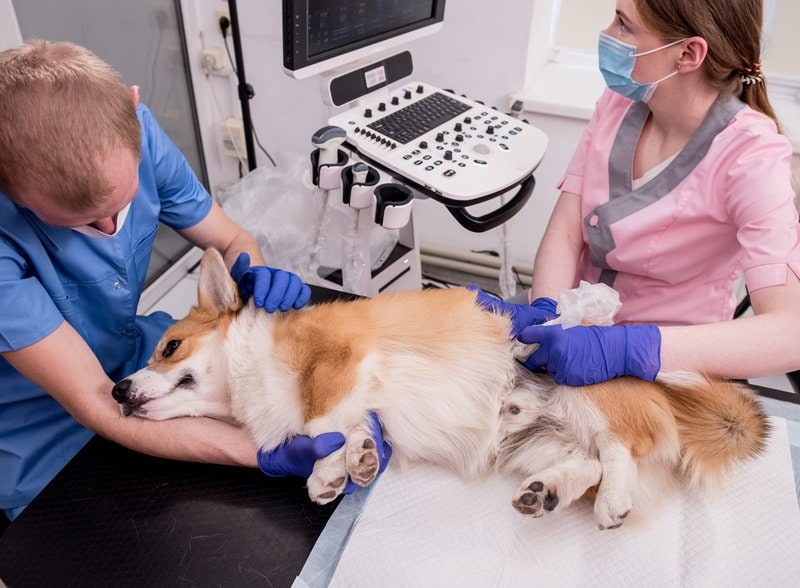Most dog lovers are familiar with the common canine diseases such as parvovirus and kennel cough. But there are other health problems that you’ve heard of but may not be too familiar with, such as Cushing’s disease in dogs.
Also known as hyperadrenocorticism, Cushing’s disease is a health problem caused by an overproduction of the hormone cortisol. A high cortisol level can lead to serious health problems such as diabetes and liver enlargement. In most cases, middle-aged dogs are affected by Cushing’s disease.
Today, we’d learn more about Cushing’s disease in dogs. Aside from pot-bellied appearance and increased urination, what are the other manifestations? Is it a hereditary condition? How is Cushing’s disease diagnosed? Is it treatable?
Find out the answers to these critical questions in this article.
What Is Cushing’s Disease In Dogs?

Cushing’s disease is an endocrine disorder that affects the production of cortisol by the adrenal glands.
These adrenal glands are located in front of the left and the right kidneys of our dogs. These glands may be small in size, but they play a big role in maintaining a healthy balance of cortisol hormones.
In some cases, the adrenal glands may underproduce cortisol. This is a condition often referred to as Addison’s disease.
On the other hand, if the adrenal glands produce more than what is needed by our dogs’ system, it leads to a condition called Cushing’s disease. This is a serious health problem that causes organ damage and complications.
How Common Is Cushing’s Disease In Dogs?
In the United States alone, it is estimated that an average of 100,000 dogs belonging to the middle-aged group (6years old and older) are diagnosed with the disease every year.
Also, statistics show that Cushing’s disease affects more females than male dogs to some degree.
What Are The Causes Of Cushing’s Disease In Dogs?

There are four causes of Cushing’s disease: adrenal gland tumors, pituitary gland tumors, breed predisposition to the disease, and Iatrogenic Cushing’s disease.
Adrenal Gland Tumor
A benign or a malignant tumor in the adrenal gland is one of the causes of Cushing’s disease in dogs. Surgically removing the benign tumor will cure Cushing’s disease. But if it’s a case of a malignant tumor, surgery may help, but the prognosis is not as good.
Pituitary Gland Tumor
It is estimated that about 90% of Cushing’s disease is due to a tumor in the pituitary gland. The tumor significantly affects the production of adrenocorticotropic hormone or ACTH.
To give you a clearer picture of how these hormones work, you will need to know about corticotropin-releasing hormone (CRH), a substance released by the hypothalamus. This hormone stimulates the pituitary gland to release another hormone called adrenocorticotropic hormone (ACTH).
The ACTH, in turn, travels to the adrenal glands to stimulate the release of another hormone called cortisol.
When everything is working fine, the cortisol levels in the bloodstream may fluctuate, and that’s normal. To maintain a healthy cortisol balance in the bloodstream, both the hypothalamus and the pituitary gland work hand-in-hand.
But, if there’s a major imbalance in the cortisol levels, that is when Cushing’s disease sets in. What causes this major imbalance is the pituitary gland tumor, which could be benign or malignant and can also be microscopic or large.
The tumor stimulates the pituitary gland to produce more and more ACTH, thereby stimulating the adrenal glands to produce cortisol.
For some dogs, the condition can be managed through medications. However, if the pituitary gland tumor keeps on growing, the brain gets affected, resulting in a less favorable diagnosis which happens in approximately 15% of dogs diagnosed with Cushing’s disease.
Breed Predisposition
Though there’s still no strong scientific evidence establishing a connection between genes and Cushing’s disease, there is data that shows some dog breeds are more likely to suffer from Cushing’s disease, and these are:
- Australian Shepherd
- Boston Terrier
- Boxer
- Cocker Spaniel
- Daschund
- Dandie Dinmont
- German Shepherd
- Labrador Retriever
- Maltese
- Poodle
- Yorkshire Terrier
Iatrogenic Cushing’s Disease
The Iatrogenic Cushing’s disease is quite common and shouldn’t cause fur parents to worry. This happens when sick dogs are administered using cortisol-like injectables or oral steroids for the treatment of dog ailments like allergies or immune-mediated anemia.
Though not all, some dogs manifest some of the symptoms of Cushing’s disease while under steroid medication.
What Are The Symptoms of Cushing’s Disease In A Dog?
Since Cushing’s disease is an endocrine disorder, it presents a wide array of symptoms. But, the most common of which are distended stomach or pot-bellied appearance and increased thirst and urination.
Pot-Bellied Appearance
Regardless of the cause of the disease, one of the common symptoms of a progressing Cushing’s disease in dogs is the pot-bellied appearance resulting from liver enlargement and increased body fat.
The liver is affected because increased levels of cortisol multiply the number of liver enzymes significantly.

Increased Thirst And Urination
Dogs with Cushing’s disease drink and urinate more frequently. Even potty-trained dogs will start to have accidents inside the house.
The exact reasons for these behaviors are not yet fully understood, but it is believed that increased cortisol is involved with the kidney’s water absorption.
This means that the kidneys produce more urine, thus, the need to empty the bladder more. As dogs urinate more, they lose water, and their water intake, thus, increases.
You may also notice a change in your dog’s behavior, appearance, as well as its capacity for disease resistance.
The other common symptoms include:
- Excessive panting
- Heat intolerance
- Hair loss
- Skin problems
- Increased appetite
- Bladder infections
- Urinary tract infections
- High cholesterol
- Diabetes
What Are The Symptoms Of End Stage Cushing’s Disease In Dogs?
Cushing’s disease is slow-progressing. Without proper treatment, the end-stage symptoms may include high blood pressure, congestive heart failure, and pulmonary thromboembolism, which can result in death.
Kidney damage, muscle wasting, blindness, myopathy, and seizures are also some of the end-stage symptoms.
How Is Cushing’s Disease In Dogs Diagnosed?
Physical exams will be done to determine the cause of the symptoms and also to rule out other possible health issues.
These tests may include urinalysis, urine culture, and adrenal function tests.
An abdominal ultrasound may also be done to rule out other health problems that could be causing the symptoms. This is because other issues like chronic liver inflammatory disease and gallbladder stones also manifest the same symptoms as Cushing’s disease.
MRI is the best way to diagnose Cushing’s disease, but this test is very expensive.

Is Cushing’s Disease In Dogs Treatable?
Yes, the only way to treat this disease is by surgically removing the tumor. The treatment for the disease depends on the type of Cushing’s disease that your dog has.
Treatment For Adrenal Gland Tumor
Major abdominal surgery can be done to remove the tumor. If the tumor is benign, there’s a big possibility that dogs can live a normal life.
If surgery is not possible, the symptoms can be managed with medications.
Treatment For Pituitary Gland Tumor
This is more complicated than treating the adrenal gland tumor. And, because of the risks involved in surgery, most often than not, dogs are given lifelong oral or injectable medications to manage the symptoms but not to treat the disease itself.
The goal is to reduce the signs of Cushing’s Disease, such as oral or injectable steroids to target skin disease, frequent urination, hair loss, and others.
There are medications used to reduce the production of cortisol, but the only FDA-approved drug is Vetoryl (trilostane).
It comes with side effects, though, such as diarrhea, weakness, and loss of appetite. The more severe side-effects of Vetoryl are the imbalance of sodium and potassium levels and bloody diarrhea.
Some vets use Lysodren (mitotane) to destroy the adrenal gland layers, but this medicine can have severe side effects.
Treatment For Iatrogenic Cushing’s Disease
In the case of Iatrogenic Cushing’s disease, the steroidal medicine is used to cause elevated levels of cortisol as a treatment, and this medication should be gradually stopped to avoid any health complications. However, this led to the recurrence of the health problem that was being treated by steroidal medication.

Is Cushing’s Disease Painful For Dogs?
Though Cushing’s disease is not always painful, it’s still on a case-to-case basis as some dogs do experience pain.
A lot of the symptoms of the disease can be managed with medicines, but the wrong dosage can cause severe side effects. This is why monitoring through blood tests is of importance.
If regular monitoring is not done, severe illnesses and death due to complications can happen.
What Is The Life Expectancy Of A Dog With Cushing’s Disease?
It depends on the cause of the disease and the individual dog itself.
If an adrenal gland tumor is a cause, the average lifespan could be about three years after diagnosis. It could be around two years if it is because of a pituitary gland tumor.
However, if the disease is diagnosed early on and the appropriate treatments are given, the prognosis is good for dogs with Cushing’s disease.
When To Put Down A Dog With Cushing’s Disease?
The decision to put a dog to sleep is never easy. However, there are some cases when medications can no longer provide comfort to the dogs.
In this case, euthanasia may be the best option if the following symptoms are already present:
- Difficulty breathing
- Renal failure
- Refuses to eat
- Weight loss
- Uncontrolled diabetes
- Seizures






